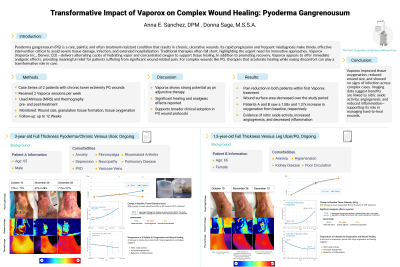Case Series/Study
(CS-143) Transformative Impact of Vaporous Hyperoxia Therapy on Complex Wound Healing
Friday, May 2, 2025
7:45 PM - 8:45 PM East Coast USA Time

Donna Sage, M.S.S.A – Director of Clinical Strategy, Vaporox Inc.
Introduction: Chronic wounds impact nearly 7 million Americans, including 2 million individuals suffering from diabetic foot ulcers. Without timely, effective intervention, these wounds often lead to infections, hospitalizations, and amputations, contributing to an estimated $50 billion annual burden on Medicare (Cho et al., 2022). The rising prevalence of obesity, diabetes, and cardiovascular disease further exacerbates the problem, underscoring the urgent need for innovative treatment solutions. Vaporous Hyperoxia Therapy (VHT) is a promising wound care modality that alternates cycles of hydrating vapor and concentrated oxygen to accelerate tissue healing. This adjunctive therapy presents a novel approach to improving outcomes in chronic wound management.
Methods: This case series assessed the outcomes of four patients with chronic lower extremity wounds treated using a multimodal protocol that incorporated VHT*. Patients received 2–3 VHT sessions per week. Near-Infrared Spectroscopy (NIRS) and thermography imaging** were utilized pre- and post- VHT and debridement sessions to monitor changes in tissue oxygenation and temperature. Clinical outcomes, including wound size reduction, granulation tissue formation, and improvements in tissue oxygenation, were tracked over a follow-up period of up to 12 weeks.
Results: The integration of VHT into the treatment protocol resulted in significant clinical improvements. All four patients experienced pain reduction within 12 weeks. Wound surface areas decreased over the 12-week period too. Peri-wound tissue oxygenation showed marked improvement after each VHT session, with an increase of over 10% after four sessions. Oxygenation within the wound bed improved more gradually but also exhibited positive healing trends, supporting favorable wound healing trajectories.
Discussion: This study demonstrates the transformative potential of VHT as an adjunctive treatment for complex wounds. The combination of VHT with advanced imaging technologies enables precise, data-driven therapeutic adjustments, facilitating personalized care. These findings provide compelling evidence for the broader clinical adoption of VHT and its integration into advanced wound care protocols.
Methods: This case series assessed the outcomes of four patients with chronic lower extremity wounds treated using a multimodal protocol that incorporated VHT*. Patients received 2–3 VHT sessions per week. Near-Infrared Spectroscopy (NIRS) and thermography imaging** were utilized pre- and post- VHT and debridement sessions to monitor changes in tissue oxygenation and temperature. Clinical outcomes, including wound size reduction, granulation tissue formation, and improvements in tissue oxygenation, were tracked over a follow-up period of up to 12 weeks.
Results: The integration of VHT into the treatment protocol resulted in significant clinical improvements. All four patients experienced pain reduction within 12 weeks. Wound surface areas decreased over the 12-week period too. Peri-wound tissue oxygenation showed marked improvement after each VHT session, with an increase of over 10% after four sessions. Oxygenation within the wound bed improved more gradually but also exhibited positive healing trends, supporting favorable wound healing trajectories.
Discussion: This study demonstrates the transformative potential of VHT as an adjunctive treatment for complex wounds. The combination of VHT with advanced imaging technologies enables precise, data-driven therapeutic adjustments, facilitating personalized care. These findings provide compelling evidence for the broader clinical adoption of VHT and its integration into advanced wound care protocols.

.jpg)